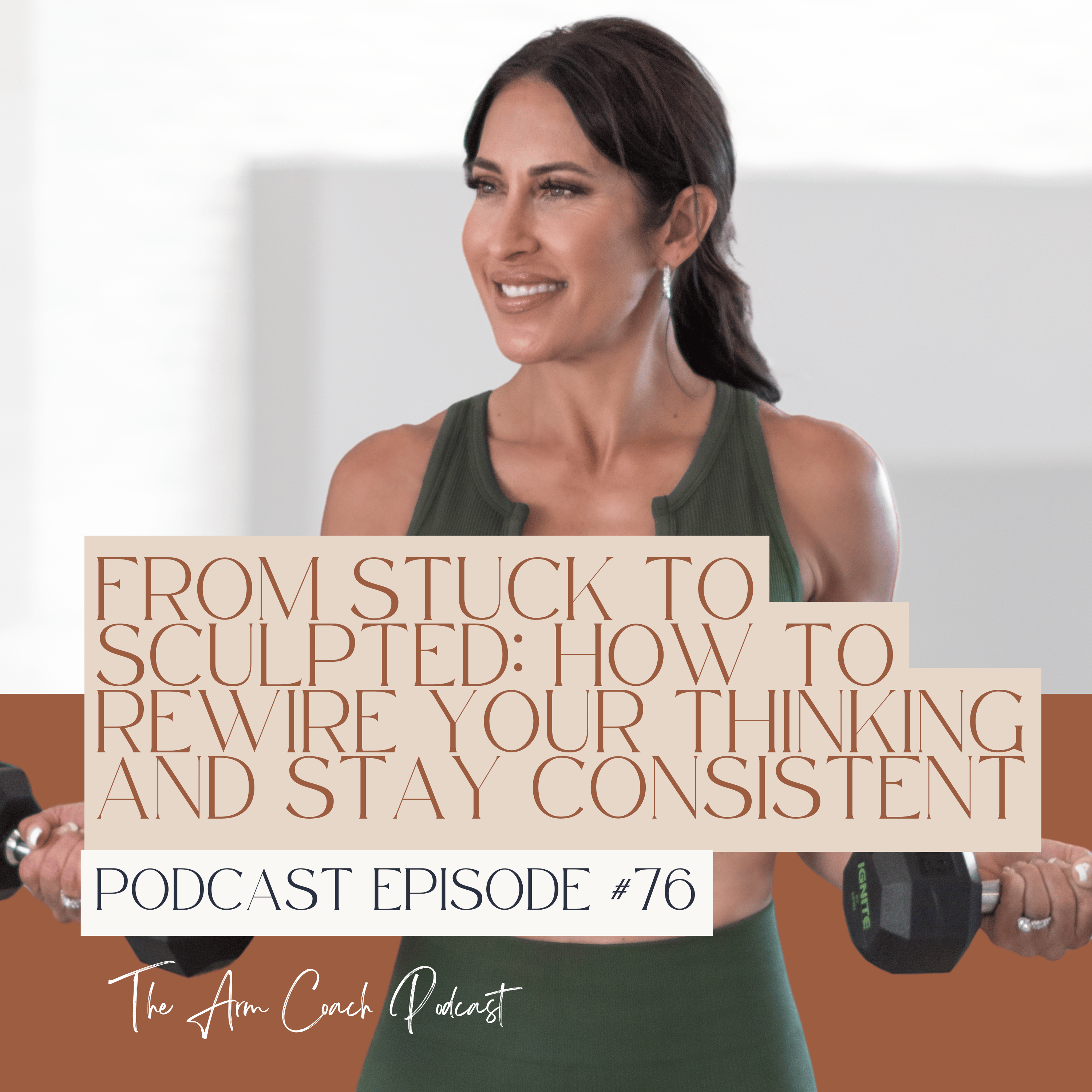Episode Transcript
Today we’re talking about the real reason it feels so hard to stay
consistent when you're working on toning your arms—and what to
do when your brain keeps telling you to quit. If you’ve ever found
yourself thinking, “This is too much work” or “Why can’t this just
be easier?”—you’re not alone. In this episode, I’m going to break
down the science behind that thought loop, show you how to
interrupt it, and help you build the one habit that changes
everything. If you're ready to stop quitting on yourself and finally
see the results you’ve been working toward, this one's for you.
Hey everyone! Welcome to The Arm Coach podcast, episode 66!
So, I wanted to talk to you today about something that’s been on
my mind a lot lately. It actually came up in a conversation I had
with one of my clients. She told me that she’s loving the tools.
She loves this work. She can feel the shifts happening—in her
body, in her mindset—but there’s still this one thought she can’t
quite shake.
And that thought is: “This is just so much work. It’s so hard. I just
want it to be easy.”
Sound familiar?
I hear this all the time. It’s such a common thought loop—this
belief that toning your arms, building new habits, following
through—it’s just too hard. That it shouldn’t feel this challenging.
And so today, I want to talk to you about why that thought comes
up so often, and what to do when you catch yourself stuck in that
loop.
The other reason this has been top of mind for me is because
lately I’ve been working on something that’s surprisingly difficult:
my balance.
I started going to this new yoga class, and I honestly thought it
would be a nice, easy reset for my body. But the first class I went
to, we got into this one-legged standing pose—nothing
fancy—and I could not stay upright. I was wobbling, tipping,
putting my foot down every two seconds. And immediately, that
voice in my head piped up: “What are you doing here? You’re too
old for this. Everyone else is doing fine. This is too hard. Just
stop.”
And it reminded me of exactly what my client was saying. I
wanted it to be easy. I expected it to be easy. And the second it
wasn’t, my brain wanted to shut the whole thing down.
But I stayed. I stayed in the discomfort. I tried again. And what
was so fascinating to me was watching how dramatic my inner
dialogue was compared to what was actually happening. My body
wasn’t failing. I wasn’t injured. Nothing was wrong. It was just
hard—and my brain wanted out.
That experience reminded me of something so important: the only
reason I haven’t improved my balance over the years is because
I’ve always stopped at this exact moment. When it gets awkward.
When it’s uncomfortable. When I’m not instantly good at it.
And that’s what so many of us do when we’re working on toning
our arms too. We do the workout. We show up a few times. And
then the soreness hits. The doubt creeps in. The scale doesn’t
move. The change feels too slow—and suddenly we’re thinking,
“This is too hard. It shouldn’t be this hard. I must be doing
something wrong.”
But here’s what I want you to know: nothing is wrong with you.
Nothing is wrong with your brain. And nothing is wrong with it
feeling hard. That’s just your brain trying to protect you from
discomfort. That’s all it is.
And when you can expect that voice to show up—when you stop
making it mean something has gone wrong—you take your power
back.
When your brain keeps telling you, “This is too hard. I just want it
to be easy,” there’s a really good reason for that. It’s not a
character flaw. It’s not that you’re lazy or broken or doing it wrong.
It’s because your brain was literally designed to avoid hard things.
From an evolutionary standpoint, that used to be a huge
advantage. Thousands of years ago, life was hard—like, actually
hard. Just staying alive required effort. Finding clean water,
hunting or gathering food, building shelter, staying warm,
protecting your kids from predators—it was nonstop survival. So
your brain developed this built-in radar to spot anything that could
conserve energy and minimize risk.
It wanted easy because easy meant survival.
Now fast forward to today. Ask yourself: how hard are you
working just to survive? Probably not very. Most of us can get
food by opening a fridge. We stay warm with the click of a
thermostat. We can get anything we need delivered without even
leaving the house. Life has gotten easier in a thousand ways—but
here’s the thing:
Your brain hasn’t updated the software.
It still thinks its job is to protect you from discomfort. So when you
start doing something that feels hard—like picking up weights,
trying to follow through on your workout plan, or making
intentional food choices—your brain throws up red flags. It’s like,
“Whoa. This is hard. Abort mission. Let’s go back to easy.”
And in today’s world, easy is everywhere. Especially when it
comes to food and entertainment.
Take food, for example. We are surrounded by processed foods
that are engineered to be hyper-palatable—meaning they’re
designed to give your brain a massive dopamine hit. Compare
that to the 1800s, when the average person consumed about
three tablespoons of sugar per week. Today? The average is a
pound and a half. Per week. That’s a massive jump—and it’s no
accident. That kind of concentrated sugar trains your brain to
expect fast pleasure. Instant gratification.
The same thing is happening with entertainment. Think about it:
Netflix, YouTube, TikTok—entire seasons, entire playlists,
delivered instantly. You don’t even have to wait between
episodes. You don’t even have to get up. Just tap, swipe, scroll,
and boom—dopamine hit.
So of course your brain resists the slower path of lifting weights or
building habits. Those things take time. They’re not flashy. They
don’t flood your brain with reward chemicals right away.
But that’s also what makes them real.
That’s the long game your brain isn’t used to playing—but it’s
exactly the one that changes everything.
And it’s not just food or entertainment. It shows up
everywhere—including in the fitness industry. Think about how
many “easy” solutions are constantly being marketed to us. Quick
fixes. Magic creams. 10-minute workouts promising sculpted arms
with zero effort. Or supplements that claim to “melt fat” while you
sleep.
Our world is filled with things that promise results without the
work—and it’s gotten more and more extreme over time. Just like
our food has been supersized, so have these promises.
And here’s the thing: those promises do light up the brain. They
speak directly to your lower brain—the part of you that wants the
shortcut, the instant hit of pleasure, the effortless transformation.
The toddler part of your brain that’s like, “That sounds amazing!
Let’s do that instead.”
And if you pair that kind of messaging with a brain that’s already
wired to seek the path of least resistance, well—you start to see
the setup.
This is why you have to supervise your brain. You have to train
it—just like you train your body. Because if you don’t, it will always
choose the easy way out. That’s just what it does. It’ll say, “Let’s
skip today. Let’s start Monday. Let’s just scroll Instagram instead
of working out.” It’s not personal. That’s just its default.
But here’s the good news: you also have a higher brain. Your
prefrontal cortex. That’s the part of you that sets goals. That can
pause. That can decide on purpose. That’s the adult in the
room—the one who can gently say to the toddler, “I hear you. But
we’re doing this anyway.”
So you have to ask yourself: who do you want running the
show? The part of your brain that’s wired for comfort, or the part
that’s capable of building the life—and the body—you actually
want?
And when you catch that voice in your head saying, “This is just
too much work”, I want you to pause and ask yourself: What do I
really mean by that?
Because I looked up the word work recently, and here’s the
definition I found:
Using your physical or mental strength or ability to get
something done or to achieve a desired result.
That’s it.
So tell me—why would that ever be too much?
What else would you rather use your strength for?
What better thing could you direct your focus, your energy, your
time toward—than building a stronger, more powerful version of
yourself?
If you’re going to use energy either way—why not use it toward
something that actually gets you somewhere?
That’s what I choose. And I think you’re ready to choose it too.
And it really got me thinking about this new goal I’ve had
lately—to improve my balance. It might sound small, but for me,
it’s become this personal challenge. I’ve been doing yoga
consistently, trying to hold these one-legged poses, and even
though I’ve been at it for a while, I still wobble. I still lose my
balance. But you know what? I’m making progress.
And the reason I’m making progress—more than I did in my 20s
when I used to talk about getting strong but never followed
through—is because I’ve stopped stopping.
I’ve stopped quitting when my brain screams, “This is too hard!
You’re too shaky! You look ridiculous!” I’ve stopped listening to
the part of my brain that tells me to sit down, skip the hard part,
and try again another day. I’ve started showing up—even in the
discomfort. Especially in the discomfort.
Now, you might think, “Well sure, you’re able to keep going
because you’re doing a class. You have structure.” And yes, that
does help. But here’s what I want you to really understand:
No one else is lifting my leg for me. No one else is making my
muscles engage. The only reason I’m improving is because of
what I decide to think when it gets hard.
The yoga teacher can cue the pose. She can say, “You’ve got
this,” or “Keep breathing.” But I’m the one who decides whether or
not I believe it.
And that’s been the biggest shift for me: I’ve started borrowing her
belief when mine isn’t strong enough. I’ve started thinking new
thoughts like, “It’s okay to shake. Progress doesn’t mean perfect.”
Or even just, “You’re doing it anyway.”
And that’s the work I want to invite you into with your arms.
Whether you’re picking up dumbbells, pushing through your final
reps, or just showing up to your tracker again—it’s not the plan
that will carry you forward. It’s the thoughts you choose to think
when the old ones try to pull you back.
You don’t need perfect discipline. You need supervision of your
brain.
And sometimes that starts with simply thinking something
new—on purpose.
And this is exactly what I see in my own clients when they come
to me wanting to tone their arms. I can’t do the workouts for you. I
can’t lift your dumbbells. But what I can do—and what I love
doing—is helping you see things differently. I can offer you a new
way of thinking when your mindset is what’s been holding you
back.
Because here’s the truth: stopping is just a habit.
If you find yourself quitting or ghosting your plan or “falling off the
wagon” every time it gets hard, it’s not because something’s
wrong with you. It’s just because your brain has rehearsed that
habit. Over and over again. Stopping is easy. And
remember—your brain loves easy.
When you stop, you get a hit of relief. Ahhh. No more pressure.
No more challenge. No more discomfort. That little bit of relief
feels good to the lower brain. And so the cycle repeats.
I’ve done this myself so many times. I’d tell myself, “This time I’m
really going to follow through.” And I’d start strong—motivated,
excited, determined. And then something would happen. I’d hit a
moment of resistance. My balance would wobble. A workout
would feel harder than expected. Or I’d look in the mirror and not
see instant results.
And then the thought would hit: Ugh.
Not even a full sentence. Just that noise. That “ugh” that tells your
brain, “Something’s gone wrong. Abort mission.” But the truth
is—nothing has gone wrong. Obstacles are supposed to show up.
That’s literally the process. Hitting resistance doesn’t mean you’re
doing it wrong. It means you’re doing it.
The problem is when we make those obstacles mean something
about us.
We think, “If this feels hard, maybe I’m not cut out for it.”
“If I missed a day, maybe I’ll never be consistent.”
“If my arms don’t look different yet, maybe I’m wasting my time.”
None of that is true.
The only way to get the result you want—the only way to tone
your arms and actually see the changes—is to keep showing up.
To keep taking action until you get the outcome. That’s the only
way. The same way you learn to ride a bike or drive a car—you
practice. You fall. You adjust. You get back on.
But if you let that old brain chatter talk you into quitting every time
things feel a little tough, you’re just repeating the stopping habit.
What I want to teach you is the staying habit. The habit of doing it
anyway.
One of the best things I’ve ever learned—something I picked up
from my own coach—is that even though our brains were built to
look for the easy way, humans are also wired to persist. We’re
meant to keep going until we reach our goal.
And I love this example she gave: It’s lucky we learn to walk when
we’re babies. Because if we had to learn to walk as adults, most
of us would probably still be crawling.
Why?
Because we’d overthink it.
We’d fall and say, “This is too hard. I’m never going to get this. I
look ridiculous. Ugh.”
But a baby doesn’t do that. A baby doesn’t make it mean
anything. They fall, and get back up. Over and over again. And
they don’t stop until they figure it out. That’s how we’re meant to
reach goals—by showing up, stumbling, adjusting, and trying
again without making it mean anything about who we are.
That’s the same exact mindset you need if you want to tone your
arms. You have to stop stopping. You have to keep showing up
even when the chatter gets loud. Even when your brain says,
“This is too hard, you’re never going to get there.”
Because what if stopping just isn’t an option anymore?
What if you practiced persistence instead of perfection?
That’s what I’ve been doing. Every time I walk back into that yoga
class, every time I wobble in a balance pose or catch myself
thinking, “You’re really going to fall over this time”, I remind
myself—that chatter can come along for the ride, but it doesn’t get
to decide what I do.
You can learn to do the same. You can see the chatter, and still
choose to take action. You can say, “I’m practicing not stopping
anymore. I’m practicing becoming the woman who finishes what
she starts. I’m practicing becoming stronger—mentally and
physically.”
And if you want help doing that—if you’re ready to stop quitting on
yourself every time it gets hard—that’s exactly what I help women
do inside Arms By Kristine.
We don’t just lift weights.
We lift the mental weight too—the self-doubt, the excuses, the
“ugh” that’s been holding you back for years.
And we replace it with strength, trust, and a plan that works
because you follow through.
You can do this.
You just have to stop stopping.
And I can help you learn how.


